Are you trying to learn the difference between the .223 vs 5.56x45mm NATO cartridges so you can use the right ammunition for your AR-15? Here’s what you need to know about their similarities and differences.
Even though many people treat the .223 Remington and 5.56x45mm NATO cartridges as interchangeable rounds, this can be a dangerous practice under the wrong circumstances. It is true that the two cartridges are very similar to each other. However, there are some very subtle, yet important differences between the 223 vs 5.56mm cartridges that go far beyond the differences in their names.
There is also a bunch of misinformation out there pertaining to this exact subject. So today, I’ll go over some of the differences between the 5.56 vs 223 Remington cartridges and provide some practices to follow when using them.
Table of Contents
Note: some of the links below are affiliate links. This means I will earn a small commission (at no extra cost to you) if you make a purchase. This helps support the blog and allows me to continue to create free content that’s useful to hunters like yourself. Thanks for your support.
Why You Should Trust Me
I’ve been hunting and shooting for virtually my entire life and have devoted a tremendous amount of time to studying firearms and ballistics. Plus, I served in the Army for over a decade with combat tours in both Iraq and Afghanistan.

I’ve put A LOT of rounds downrange through various rifles chambered in 223 Remington and 5.56 NATO over the years and I’ve seen firsthand how things can go wrong when the shooter utilizes the wrong ammunition.
So, I know a thing or two about the AR-15 platform as well as the 223 Remington and 5.56 NATO cartridges and I won’t steer you wrong!
223 vs 5.56 NATO Differences
I recorded an entire video episode on this exact subject. If you’d rather listen or watch than read, watch the YouTube video below.
As you can see in the photo below, .223 and 5.56mm rounds have virtually identical external case dimensions. This means that the majority of the time, it’s possible to chamber and fire .223 ammunition in a 5.56mm chamber and vice versa.
This can lead to problems though.
This is also where things start to get confusing.
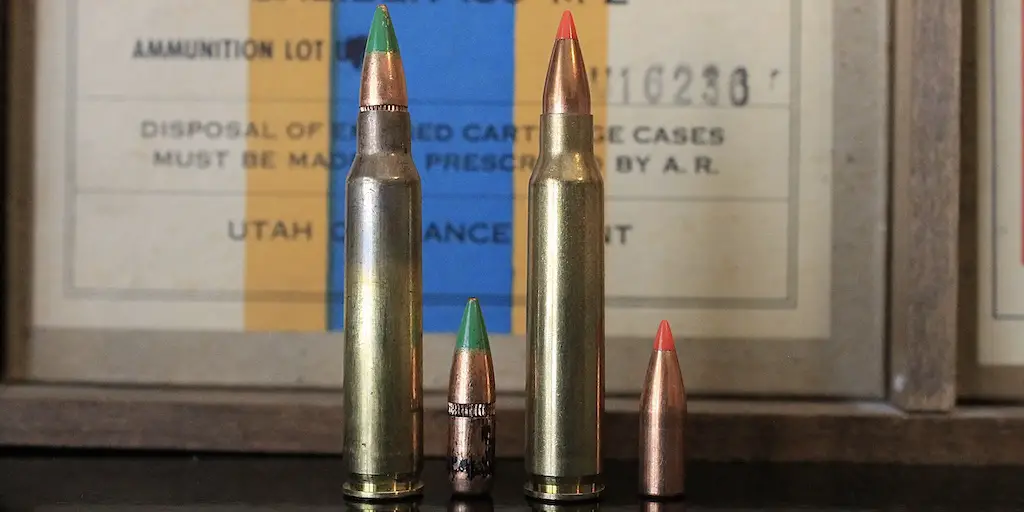
Making an apples to apples comparison of the authorized pressure of the two rounds is difficult because the .223 Remington cartridge is standardized by the Sporting Arms and Ammunition Manufacturers Institute (SAAMI) while the 5.56×45 mm NATO cartridge is not.
Even so, 5.56x45mm ammunition is often recognized as being loaded to a higher pressure than the 55,000psi maximum average pressure standardized by SAAMI for the .223 Remington.
The details here are very confusing and you’ll often encounter seemingly contradictory information from reliable sources.
For instance, Hornady says on p174 of their 10th Edition Reloading Manual that:
SAAMI (Sporting Arms and Ammunition Manufacturers Institute) maximum pressure for the 223 Remington is 55,000psi. The 5.56 NATO is loaded to 60,000psi.
Likewise, it says on p73 the 17th Edition of Cartridges of the World that:
5.56 NATO ammo is generally loaded to a higher pressure than commercial .223 Remington ammunition.
Winchester echoes a similar sentiment on their web site when they say:
The 5.56 round, loaded to Military Specification, typically has higher velocity and chamber pressure than the .223 Rem.
Nosler echoed that sentiment in their #9 Reloading Guide and had the following to say on p111:
The 5.56x45mm NATO is loaded to a higher pressure level and must never be fired in guns labeled 223 Remington.
However, Hornady also says the following on their web site:
The first difference is the higher pressure level of the 5.56 NATO cartridge which runs at approximately 58,000 psi. A 223 Remington is loaded to approximately 55,000 psi.
So, it seems pretty clear that the folks at Hornady are in agreement that the 5.56 NATO is a higher pressure round than the 223 Rem, though they claim a maximum pressure of 58,000psi for the 5.56×45 mm cartridge on their web site and 60,000psi in their reloading manual.
A short search online will find plenty of other articles saying similar things, but you’ll also find other sources that disagree entirely with the premise that the 5.56 NATO is a higher pressure round than the 223 Remington.
With all that in mind, I don’t blame you for being confused!
What’s the real story with 223 vs 5.56 pressures?
As far as I can tell, the two cartridges are designed to operate at essentially the same pressure when fired in their respective chambers.
If you fire 5.56×45 mm rounds in a 5.56 NATO chamber, pressures will not exceed 55,000psi (assuming the ammo and chamber are both in good condition, both are within spec, etc.).
The same is true if you fire 223 Remington ammo in a 223 Remington chamber.
With all that said, 5.56x45mm NATO ammo can be loaded a little hotter and is capable of firing the same weight bullet at a slightly faster velocity (everything else being equal) than the 223 Remington.
How is this possible if both cartridges have virtually identical case dimensions and operate at the same maximum pressure in their respective chambers?
Stay with me here.
I know it may seem like I’m trying to play word games, but in addition to other more obvious factors like the type and amount of powder used as well as the weight and type of bullet in question, chamber design also affects pressure.
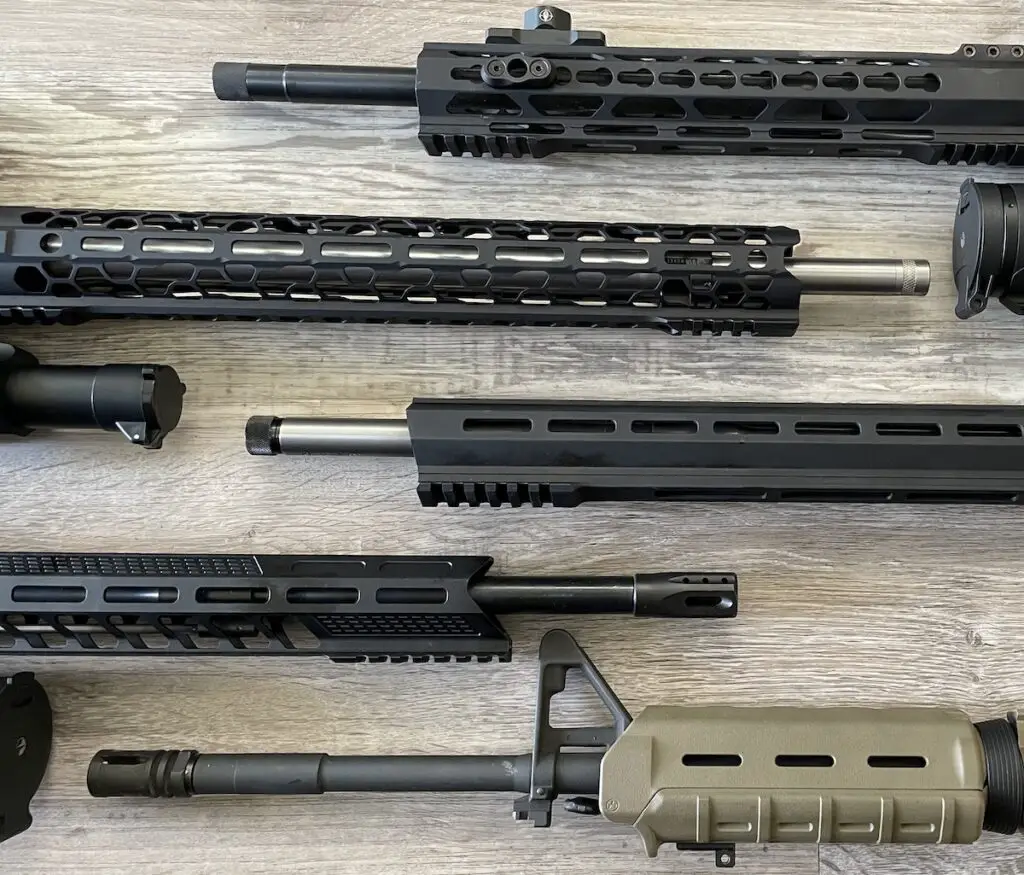
This brings me to my next point.
There’s a very important difference between the 5.56 vs 223 that basically everyone agrees on: the chamber dimensions for the two cartridges are slightly different.
In fact, though it may seem like a minor distinction at first, this is a major difference that can have a significant impact on the ballistic performance of the 223 Remington and 5.56 NATO rounds.
Specifically, .223 Remington chambers have a shorter leade (the distance between the case mouth of the cartridge and the point where the rifling engages the bullet) than 5.56mm chambers.
This is the sort of chamber design principle that’s more common with sporting rounds like the 223 Remington.
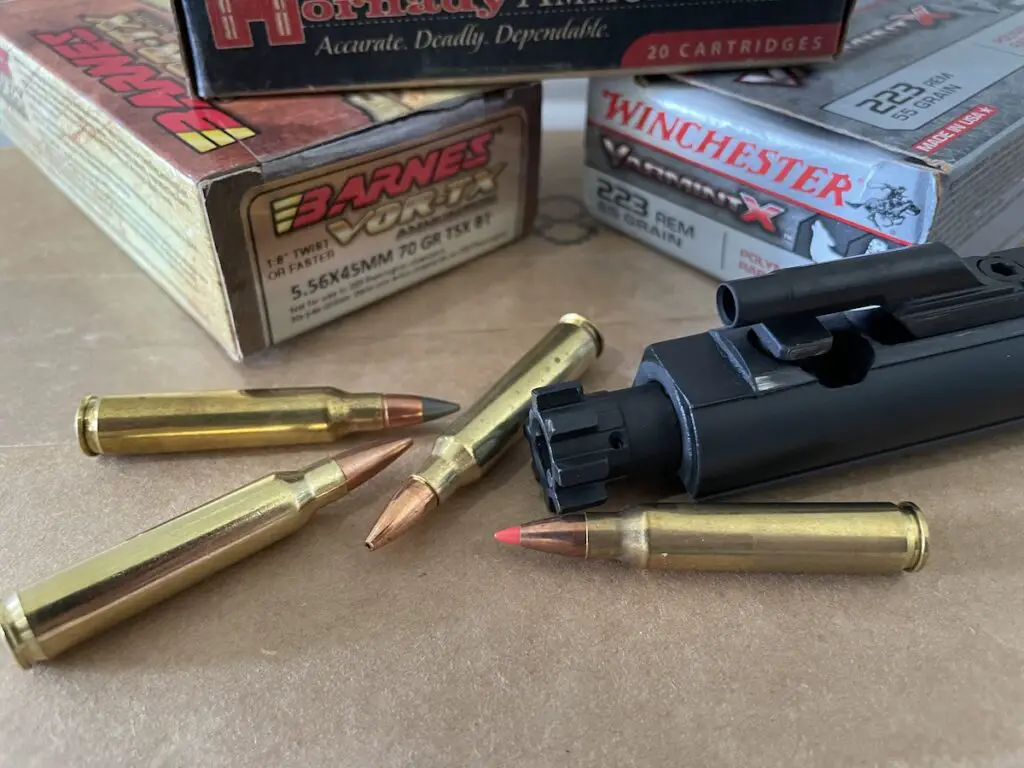
On the other hand, the 5.56x45mm NATO cartridge was originally designed for the U.S. Military to use in the M-16 rifle. Indeed, the M-16A1, M-16A2, and M-4 rifles and carbines commonly used by the US Army and Marine Corps (as well as the other branches of the military) over the past few decades are all chambered in 5.56 NATO.
Due to the military roots of the cartridge, the 5.56mm NATO round was designed for use with a longer leade with a shallow angle (in contrast to the shorter leade and steeper angle of the 223). This longer and shallower leade has the advantage of improving reliability by allowing more build up of carbon and other “gunk” rifles often accumulate in the harsh conditions of a battlefield without adversely affecting the function of the rifle.
The 5.55 chamber design also facilitates the use of “hotter” loads without excess pressure.
Like I mentioned earlier, chamber geometry also directly affects chamber pressure in a firearm and changing the throat and leade geometry (like by introducing a longer throat and/or a more shallow leade angle) in a chamber can result in wildly fluctuating pressures, even when the exact same ammunition is used.
This means that firing 5.56mm ammunition (which remember, Hornady, Nosler, and Winchester all agree is loaded a little hotter) out of a .223 Remington chamber with its shorter leade can produce dangerous amounts of chamber pressure.
This brings us to our next point.
5.56 vs 223 Remington: What’s Safe For You To Shoot In Your AR-15?
Can you shoot 223 in a 5.56 chamber? Yes. .223 Remington ammunition may be shot safely in a 5.56mm chamber.
Firing 223 Remington ammunition in a 5.56 NATO chamber will result in lower pressure compared to firing that exact same ammunition out of a 223 Remington chamber due to the aforementioned differences in chamber geometry. Doing so won’t be dangerous, but you’ll likely experience reduced velocity, potentially reduced reliability (especially with gas operated guns), and possibly degraded accuracy.
Can you shoot 5.56 in a 223 chamber? No. Do not shoot 5.56mm ammunition in a rifle with a .223 Remington chamber or you are risking a potentially dangerous incident.
Indeed, firing a 5.56mm round in a 223 Remington chamber can potentially result in higher chamber pressures in excess of 65,000psi (well in excess of the 55,000psi the cartridge is designed to operate at).
While it’s safe to shoot .223 Remington ammunition in a 5.56x45mm chamber, the reverse is not true.
Like I mentioned earlier, if you fire 5.56mm ammo in a .223 chamber, you could experience serious trouble from a pressure spike that potentially results in damage to the firearm and/or injury to the shooter in extreme cases.
More likely, the excess pressure levels will blow the primer out of the primer pocket into the internal workings of the rifle. Even so, this is still a big deal!
So, stop shooting that ammunition in your rifle immediately if you observe or experience any signs of excess pressure like a sticky bolt on a bolt-action rifle or blown, cratered, or flattened primers in your spent cartridge case.
Primers that look like this are signs of excess pressure!
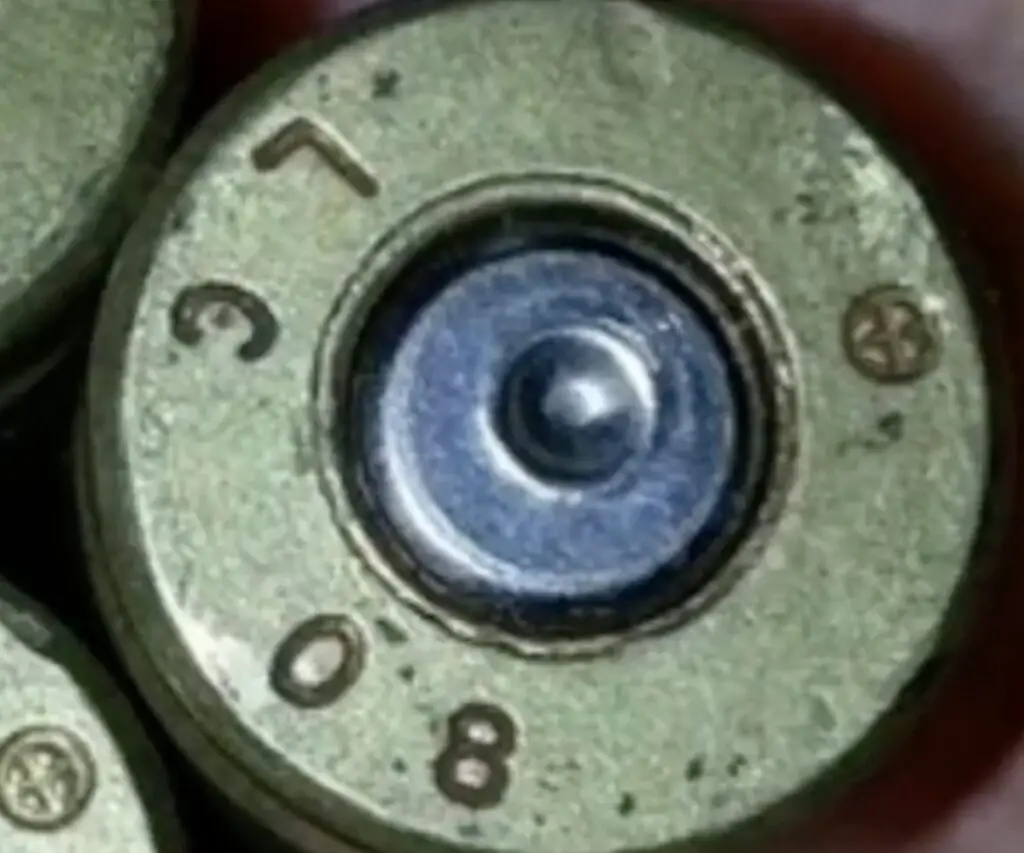
With all that said, it’s important to emphasize that not only is it safe to shoot 223 in a 223 chamber and 5.56 in a 5.56 mm chamber, but you’ll probably also experience the best overall performance in those situations.
223 vs 5.56: What Kind Of Rifle Do I Have?
To avoid a potentially dangerous situation with excess pressure, ensure that you only fire the appropriate ammunition in your rifle.
First, find out if your rifle (or handgun) is chambered in .223 Remington or 5.56mm NATO.
On AR-15 rifles or carbines, look on the top of the barrel near the muzzle. On most other sporting firearms (like bolt action rifles), look on the receiver or the side of the barrel near the chamber. If it says “.223 Remington” or “5.56 NATO” like in the photo below, then you can be pretty sure that is what you have.
The 1/7 denotes the rifling twist rate of this rifle and we’ll discuss this more later.

If you have a bolt-action rifle, it’s very likely chambered in 223 Remington.
Rifles like the Winchester XPR, Browning X Bolt, Ruger American Predator, and older versions of the Ruger Mini-14 are chambered in .223 Remington.
Some bolt-action rifles are chambered in 5.56 NATO though, like the Ruger American Ranch rifle.
On the other hand, so called “modern sporting rifles” like the AR-15 and other semi-auto rifles (like current production Ruger Mini-14 rifles) are more often chambered in 5.56x45mm NATO.
Though they certainly exist, modern production semi-automatic rifles are very rarely chambered in .223 Remington.
What About The 223 Wylde?
A man named Bill Wylde designed a hybrid .223/5.56 chamber he named the .223 Wylde that’s optimized to provide the accuracy advantages of a match .223 Remington commercial rifle chamber without pressure or reliability failures when using high velocity 5.56 NATO spec ammunition.
Like a rifle with a 5.56 NATO chamber, a rifle with a properly cut 223 Wylde chamber can safely shoot both 223 Remington and 5.56 NATO ammunition. However, the .223 Wylde will generally deliver better accuracy than a 5.56 chamber because it has a tighter chamber throat.
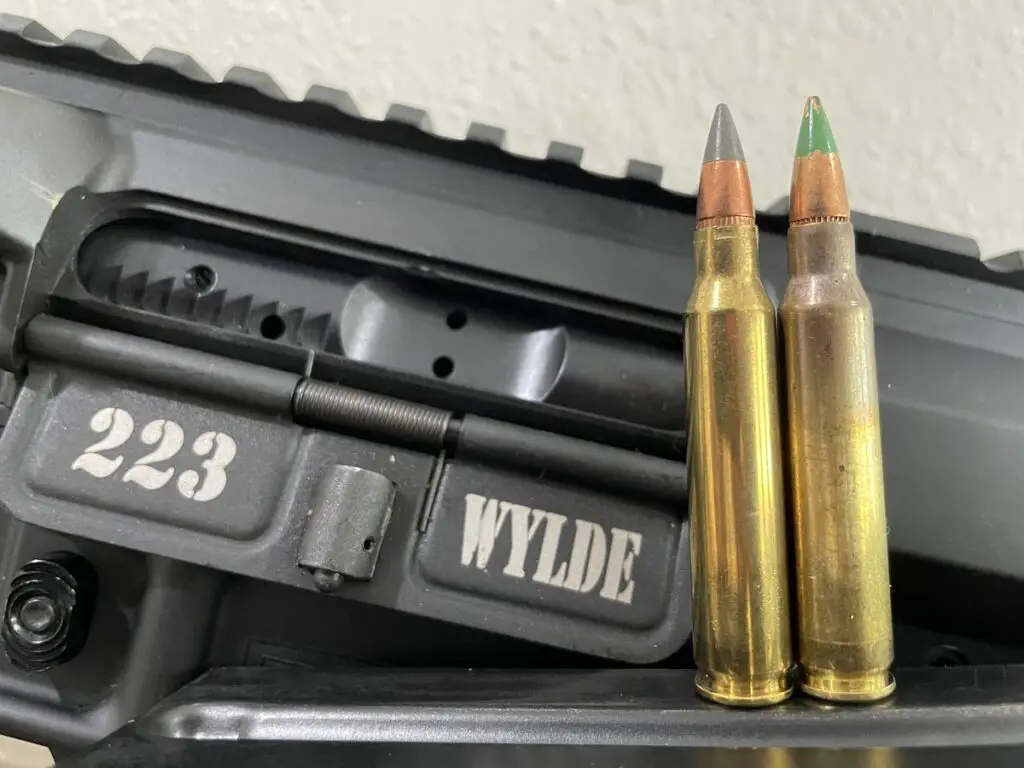
For this reason, the .223 Wylde chamber is very popular among competition shooters using AR-15.
What about 5.56 Noveske chamberings? Just like with the .223 Wylde chambering, you can safely use both .223 Remington and 5.56x45mm NATO ammunition in Noveske chambers.
What About Rifle Twist Rate?
Though this is not a major factor in terms of safety, it’s important to realize that 5.56 NATO and 223 Remington rifles often utilize barrels with different rifling twist rates.
The SAAMI spec twist rate for the 223 Remington is 1:12″.
That said, it’s not difficult to find rifles chambered in the cartridge with faster rifling twist rates that can stabilize longer and heavier bullets.
The 5.56x45mm NATO is not a SAAMI standardized cartridge, but rifles in this chambering generally have faster twist rates 1:9, 1:8, and even 1:7 twist rates that facilitate the use of very heavy bullets are pretty typical.
223 Wylde chambers often have a pretty fast twist rate as well.
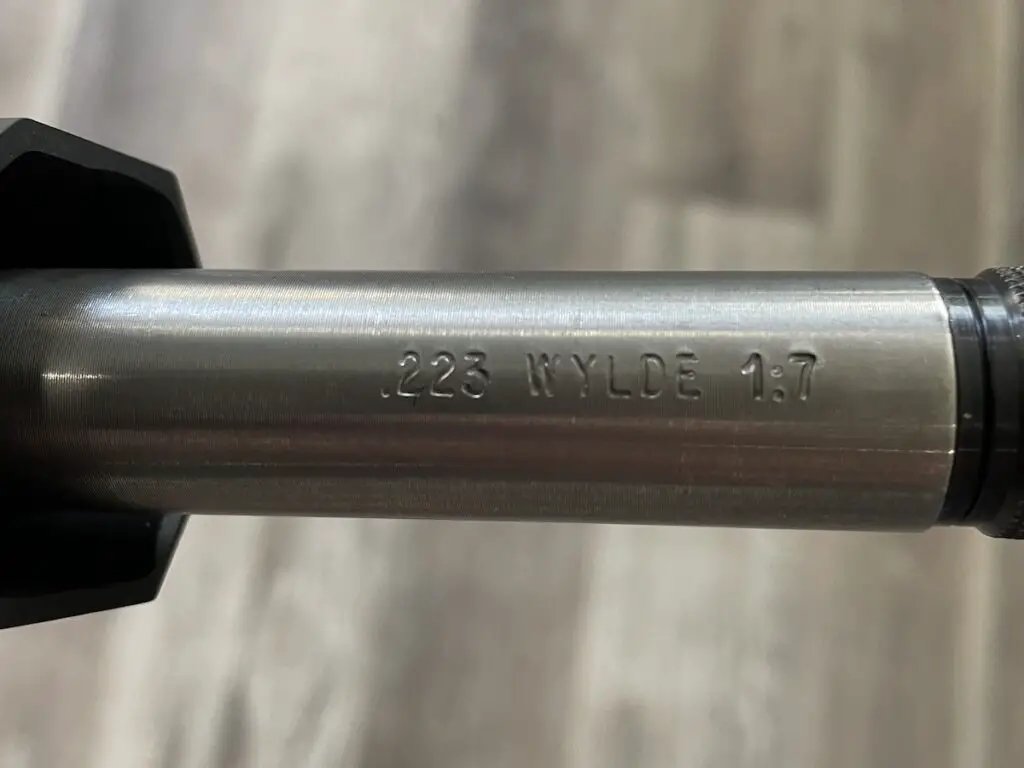
5.56 vs 223: What Kind Of Ammo Do I Have?
So how do you determine if a particular type of ammunition is .223 Remington or 5.56x45mm NATO?
First off, take a look at the box the ammunition came in if you still have it. It usually is that simple.
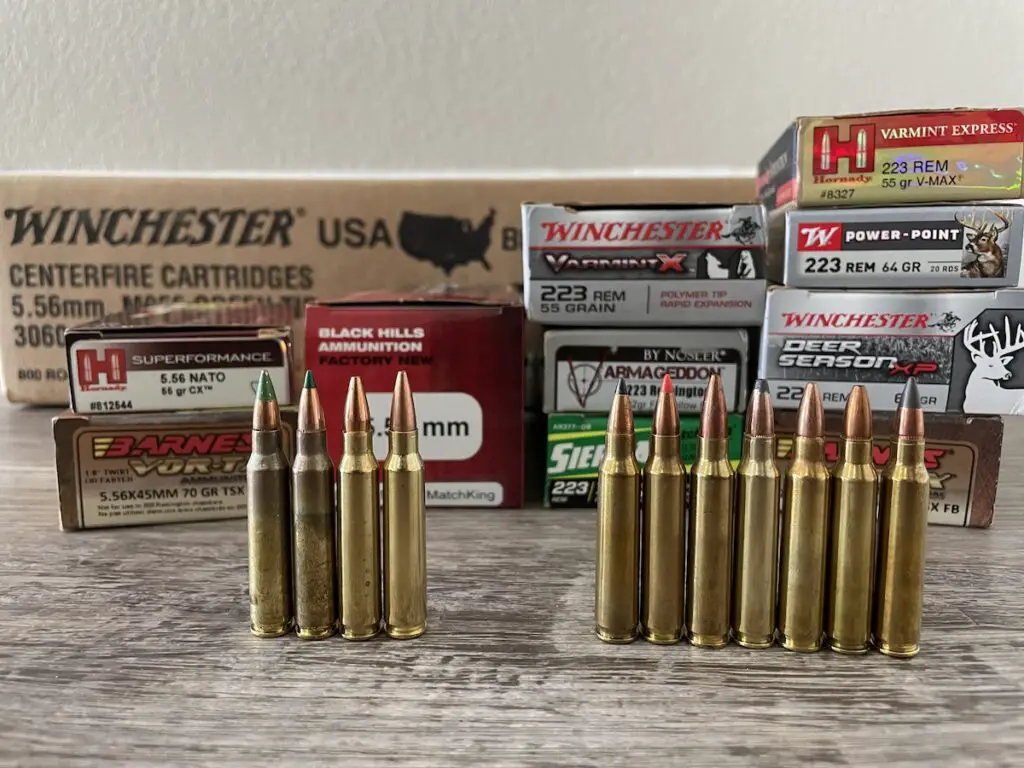
Believe it or not though, not all boxes will clearly say “223 Remington or “5.56 NATO” though.
Due to its roots as a military cartridge, there is a lot of surplus military ammunition in 5.56x45mm NATO on the market. If the ammunition is packaged as M193, M855, SS109 (or a variant of those like XM193 or XM855), it is definitely 5.56mm.
But what if you don’t have the original box? Or if some of your ammunition got mixed up?
In that case, look at the headstamp on the base of the bullet.
If the headstamp says “5.56x45mm” or is 2-3 letters and 2-3 numbers (such as “LC 13” on the left in the photo below), and/or has a cross inside a circle (which indicates it meets NATO mil-spec requirements), then it is military surplus full metal jacket (FMJ) 5.56mm NATO ammo.
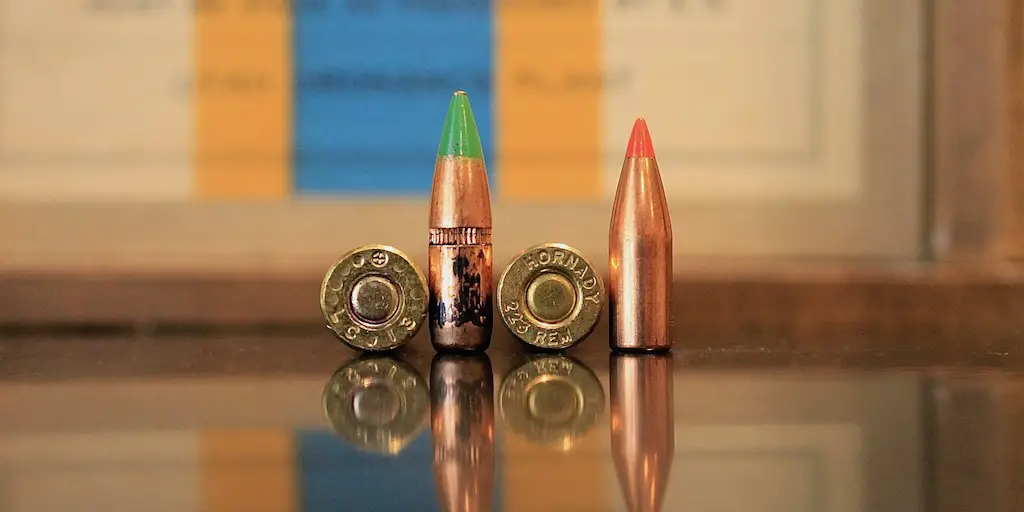
If the headstamp says something like “Hornady 223 Rem,” like the cartridge on the right above, then it is a .223 Remington round. Likewise, hunting and self-defense ammunition made by civilian ammunition manufacturers like Winchester’s Super-X, Hornady’s Varmint Express, and Nosler’s Varmageddon product lines are usually (though not always) made to .223 SAAMI specifications.
If you are still not sure after looking at the headstamp, treat the ammunition as 5.56mm just to be on the safe side.
And just so we’re clear: NEVER attempt to shoot ammunition for any other cartridge in a 223 Remington, 223 Wylde, or 5.56 NATO chamber.
Most cartridges won’t chamber at all, but the 300 Blackout is a notable example of a round that will chamber and fire with catastrophic consequences in a 223 or 5.56 chamber.
This photo I took at my local shooting range is a good example that trying to push a .30 caliber bullet down a .22 caliber bore is a recipe for disaster!
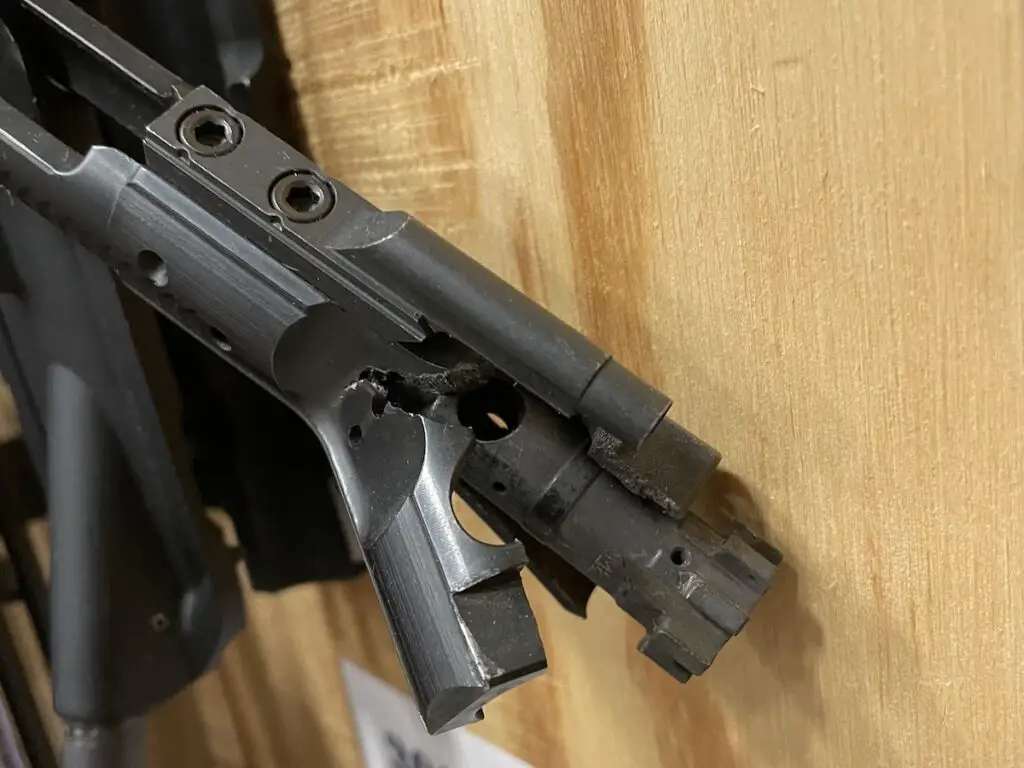
Both the 223 Remington and 5.56x45mm NATO are excellent cartridges with a lot of utility for hunting, target shooting, and self defense. Links to my favorite hunting/self-defense loads for each cartridge are below.
BUY SOME GREAT 5.56x45mm AMMO HERE
BUY SOME QUALITY 223 REMINGTON AMMO HERE
If you’d like to learn more about some of the various hunting ammunition options for the 223 Remington (which will also work in a 5.56 NATO rifle), read this article:
Best 223 Ammo For Hunting Deer And Other Big Game
5.56x45mm NATO vs 223 Magazines
We can’t talk about the 223 vs 5.56 without at least mentioning magazines. Both cartridges should function well with most standard AR-15 magazines.
That said, magazines may be the single biggest cause of feeding problems with both the 223 Remington and the 5.56 NATO.
Things like a weak spring, bent feed lips, dirt inside the magazine, or a dent in body can all result in malfunctions. The same is true for using just a cheap or poor quality magazine in general.
Fortunately, this is a simple and relatively inexpensive problem to avoid.
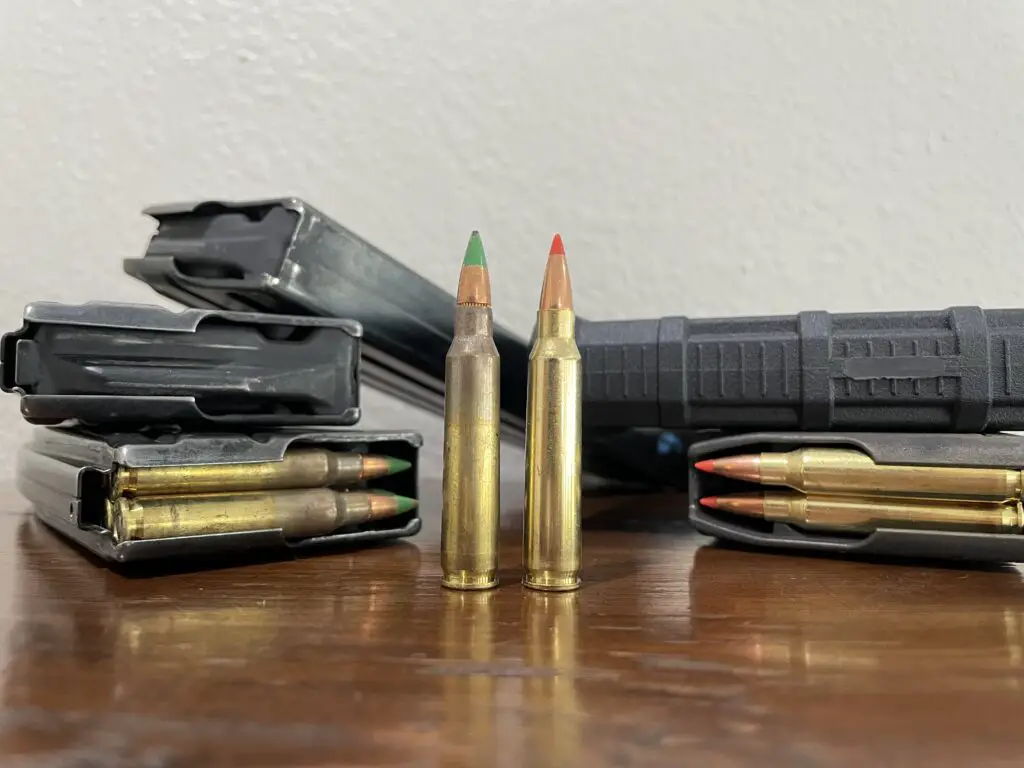
I exclusively use Magpul and H&K magazines in all my AR-15s.
Magpul magazines are excellent: they’re lightweight, reasonably priced, and work really well.
I’ve used a mix of the Gen2 and Gen3 Magpul magazines with a lot of success over the years and it’s tough to go wrong with them.
That said, as good as Magpul magazines are, H&K steel sand resistant magazines are the ONLY AR-15 magazines I’ve NEVER had an issue with.
They’re heavier and much more expensive than the Magpul magazines, but I do believe you get what you pay for here. In fact, I even went so far as to purchase a bunch of the H&K magazines to use on my deployments to Iraq and Afghanistan back when I was in the Army.
They’re what I used when my life depended on it and they have never let me down.
Whichever brand you go with, I’d recommend purchasing at least 10 magazines right now using the links below. Stock up on them while you can while they’re still easy to get and while prices are still at least somewhat reasonable!
BUY SOME MAGPUL MAGAZINES HERE
223 Remington vs 5.56x45mm NATO Conclusions
If you’re looking for a rifle to shoot the widest variety of ammunition, get one chambered in 5.56x45mm (and verify that it does indeed have a 5.56mm chamber) or in 223 Wylde as this will let you shoot both cartridges safely.
To learn about some of the many cartridges designed to improve upon the .223 Remington and 5.56x45mm NATO and still function in an AR platform, check out these articles about the .224 Valkyrie, .300 Blackout, the 6.5 Grendel, the 6.8 SPC, the .450 Bushmaster, the .458 SOCOM, and the .50 Beowulf:
.300 Blackout vs 7.62×39: Everything You Need To Know
223/5.56 vs 300 Blackout vs 308 Winchester: Which Is Best?
6.5 Grendel vs 6.5 Creedmoor: Which 6.5 Is Right For You?
6.8 SPC vs 6.5 Grendel: What You Need To Know
224 Valkyrie: Should You Buy One?
450 Bushmaster vs 458 SOCOM vs 50 Beowulf: Battle of the Big Bore AR Cartridges
The Hornady 10th Edition (p160-178) reloading manual, The American Rifleman,and the Guns & Ammo Network were used as references for this article.
Enjoy this article describing the differences between the 5.56 vs 223? Please share it with your friends on Facebook and Twitter.
Make sure you follow The Big Game Hunting Blog on Facebook, Instagram, Twitter, and YouTube.
NEXT: HOW TO ZERO THE BACK-UP IRON SIGHTS ON AN AR-15
NEXT: 101 BEST GIFTS FOR HUNTERS
John McAdams is a proficient blogger, experienced shooter, and long time hunter who has pursued big game in 8 different countries on 3 separate continents. John graduated from the United States Military Academy at West Point and is a veteran of combat tours with the US Army in Iraq & Afghanistan. In addition to founding and writing for The Big Game Hunting Blog, John has written for outdoor publications like Bear Hunting Magazine, The Texas State Rifle Association newsletter, Texas Wildlife Magazine, & Wide Open Spaces. Learn more about John here, read some of John’s most popular articles, and be sure to subscribe to his show: the Big Game Hunting Podcast.


While I understand it’s “safe” to fire .223 in my AR – 5.56…
…I am curious as to what, if any performance issues there may be with the rifle ?
I know I will have different performance from the bullet down range at longer distances, but what about the rifle itself – will it foul up quicker, and/or be more susceptible to jamming, and/or needing to be cleaned more frequently ???
Thanks in advance for any input.
There might be a tiny drop off in accuracy and/or reliability by shooting 223 ammo in a 5.56 (and vice versa), but there difference has not been big enough for me to notice myself.
John
Will 223 ammo preform better in a 556 AR than 556 ammo. 223 is reloaded with more powder than 556.